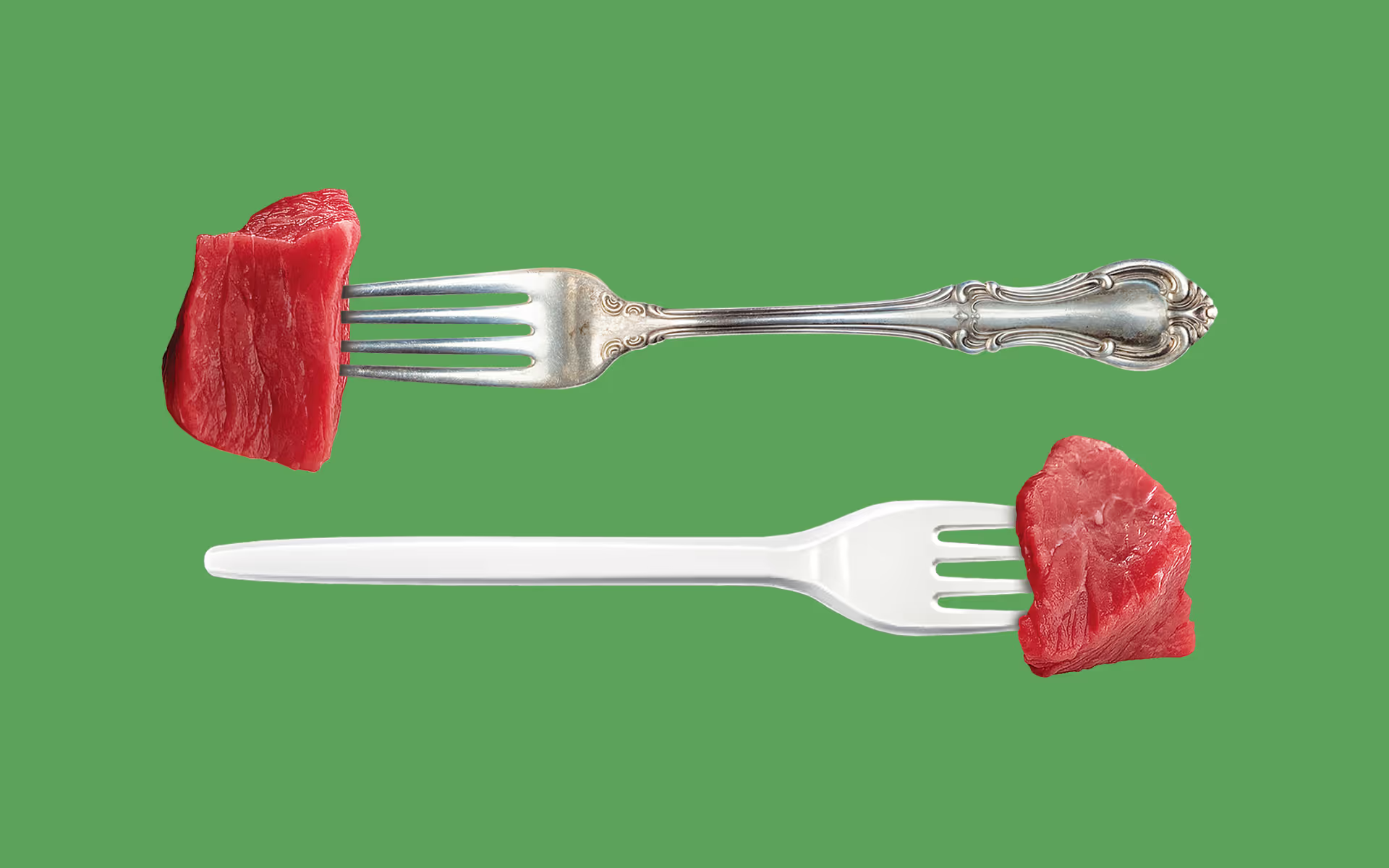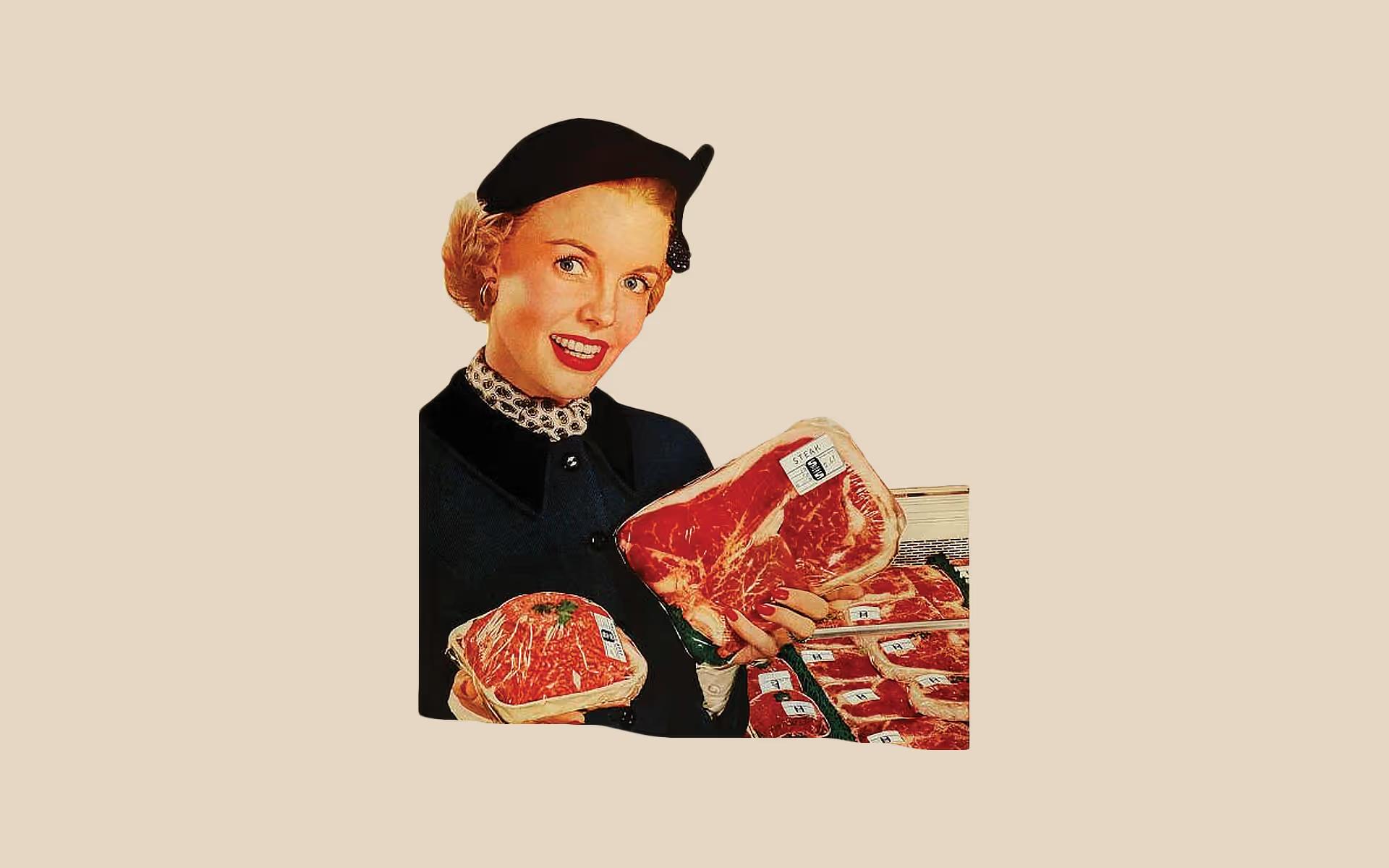We are living in a unique moment in history; Long gone are the days when we had to spend an afternoon sharpening a stone with our unwashed buddies and go out into the wilderness, and risk life and limb to try and put down a mastodon. We don’t even have to have the extreme luck of being born into nobility anymore, nor do we have to wait for the holiday feast. We don’t have to spend parts of our days tending to animals from which we want to extract something. Now, almost anywhere you go, it’s there: sizzled, grilled, baked, roasted, fried, cured, and even dipped into Bloody Mary cocktails.
It is simply astonishing how much meat’s presence and availability has grown in the Western world in the past 100 years.
The current prevalence of meat products and the convenience of attaining them makes it rather easy to ignore the scientists, experts, and environmentalists who want to spoil the moment with words like “less,” and “moderation,” and “sustainability.” Those reasonable, peer-reviewed, empathic pieces of shit.
Like something that is so large that it’s beyond your scope of vision, it’s hard to grasp the meat industry’s near-divine power over the food market and how much our world and environment are affected by it.
So how did we get from waiting months for a roast with the family to being able to casually stuff a duck into the ass of a chicken and shoving all of that through a turkey’s ass (an actual dish called turducken) any day of the week?
The Old-World Status Quo
Before the European settlements of America, almost all work was related to the land and its natural resources, most of it being agricultural. If we were born at that time, it’s very likely the majority of us would have been born as lowly commoners. With hand tools and grit, we would have spent sweaty spring and summers tending to farm work.
Since the spawn of civilization, bread and other grain-based foods were the most common food (and drink: beer), and depending on the season, various vegetables were made into stews. During the harsher winter seasons, these meals would incorporate carefully prepared meat. The vast majority of meat was funneled to the upper classes as it was the most expensive to produce, while livestock, for the most part, was kept for dairy goods. The commoners could fish and catch some fowl, but epic meal times were reserved for the asshat nobles.
New Land, New Rules
The first changes to the dietary status quo began as America was starting to become a thing. Teeming with fauna and with too few hands to grow crops, vast traveling distances, and relatively short growing seasons in the Northern colonies, it was simply convenient to raise livestock and to just hunt.
Along with the European newcomers; pigs, cattle, sheep, and horses also made themselves at home. Additionally, the settlers brought with them culinary customs and notions of nutrition. Out of all the ethnic groups who pushed for a meat-centric diet, the Germans (people who came from an area that would later be known as Germany) made a particular impression
As a result, today the city of Hamburg is inadvertently mentioned at least 440 times a second 🍔
Interestingly this is not just an American phenomenon. Australia, New Zealand and Argentina, are on the same podium for eating meat per capita a day, and all are nations with similar histories of settlement and colonization.
This habit surprised even the immigrants who arrived later to the nation, some wrote back home to their mamas on how they ate meat every day. Up to the American Civil War, it is estimated that Americans were eating over a burger a day considerably more than the average of the entire world even though most of the livestock was raised and slaughtered locally.
The post civil war years saw a surge in demand for beef which required new methods to sustain the larger herds needed and new ways to move them cross country.
Technologies and Logistics that Changed the Game
Railroads
During the middle of the 19th century railroads started lining the nation which allowed livestock to be transported from grazing lands to slaughterhouses in a considerably shorter period of time. Cows were no longer chosen for their fitness but for their plumpness. This in combination with coordination with city-based packing houses saw meat become more readily available and its price started to decrease significantly.
Refrigeration
It led to the first real push to beef's growing worldwide appeal. By the 1880s, American beef was finding its way all the way to England. Further developments to refrigeration and freezing during the early 20th century helped push prices down.
Meatpacking
Or ‘’Packing houses’’ are factories where the Kafkaesque butchery from animal to meat is streamlined. After the war, their growing presence helped popularise beef consumption. With the addition of the above two technologies, meatpacking became a colossal industry during that period.
Cattle Drives & Towns
Stretching for miles, cows in the thousands would be herded from the closest grazing lands to the nearest markets and towns to be put on trains. It was an arduous activity that brought to popularity the image of the rowdy cowboy.
Ideally situated where railroad and cattle trails crossed, so-called cattle towns prospered during this time. As infrastructure and logistics improved by the end of the 19th-century, long-distance cattle trains ended after a short but prosperous period.
By the beginning of the 20th Century, these four technological and logistical developments helped consolidate the burgeoning new meat industry and turned it into a colossus. Meat variety grew while prices decreased, especially for beef, enough to make it America’s every day and every man's food. Although meat (beef at this time) became inclusive to most Americans, its exclusive status as the royalty of food remained.
The Jungle
It was in 1906, during the packing house boom, Upton Sinclair’s book, The Jungle, was published. Having spent some time undercover in packinghouses, Sinclair describes in detail the cruelty and awful working conditions within them. Although his socialistic message was largely ignored (censorship had a part in it), most of the public sentiment centered on food safety which he so wittingly pointed out, "I aimed at the public's heart, and by accident, I hit it in the stomach.".
A public outcry ensued, followed by governmental action, which resulted in the following:
- Meat, for the first time in US history lost some of its popularity.
- The first food health and safety standards and regulations were set in place.
- City folk started pushing away plots and packing houses from the cities and into the countryside. The government pitched in to help create market centers, centralizing and consolidating the farming and livestock industry.
These changes did pave the way for improved standards and regulations but left many of the issues unresolved.
Centralization and Mega Farms
When packinghouses and livestock farms were pushed farther out to the countryside, opportunities for expansion and consolidation arose. Large ranches started consolidating and buying up other farms. This continued on until the growing industry became what is now lovingly called BIG MEAT. It is essentially 5 large farms/corporations running the whole show.
From the 1950s onwards to the 1980s, demand for meat was at an all-time high and growing, but the price of land started to rise. To meet demand without raising the prices too much, Big Meat started experimenting and finding new ways to push animals to their limits. With the synthesis of vitamin D, animals were moved indoors into confined spaces. Chickens were the first to face this corporate and inconsiderate decision which then became the norm for other livestock.
To plump animals up further and turn them into giant grotesque and hopefully still edible mutants, meat by-products and hormones are added to their feed. It has reached a point that livestock makes up 60% of all mammals on earth.
Meat consumption during that time reached a little under 2.5 burgers a day per person. The current EU average is 1.5 burgers per person a day, and the global average is around 0.8 burgers.
If you think conditions are only bad for animals in battery farms, oh boy, the rest of what you are about to read is from Human Rights Watch. Even with the improvements of conditions and regulations put in place after the publication of ‘The Jungle’, to this day working in the meat industry is still considered to be extremely:
Dangerous: tough repetitive conditions and with one of the highest accident and severe accident counts even when compared to other industries that are considered hazardous.
Psychologically Gruelling: long hours and continuous harsh treatment of animals in poor conditions take their toll on the mental health of laborers.
Exploitative: All of the above and yet the wages are puny (decreased by 44% since 1985). The industry has a long track record of using undocumented immigrant labor.
And then again, this all just the tip of the melting iceberg.
The disconnect
As of today, 99% of all animal products in the United States come from a factory farm. Somehow meat is still presented as if it’s brought to you by old Macdonald with happy cows frolicking around on pastures.

Yet even with all its availability and the dodgy production methods, it’s still regarded above all other foods. It is as if someone rolled up in what appears to be a Rolls Royce, but underneath the hood there is an old rusty ass Pinto engine sputtering. Plus, instead of an opulent interior we are met with torn upholstery, the smell of cigarettes and human despair. It’s still a car but it isn’t a Rolls - no matter how much we try to disguise it.
To fulfill such an artificially created hunger for meat there just isn’t a safe, environmentally and ethically sound means of production. Long gone are the days when I would have never questioned eating meat, today we live in an entirely different world.









